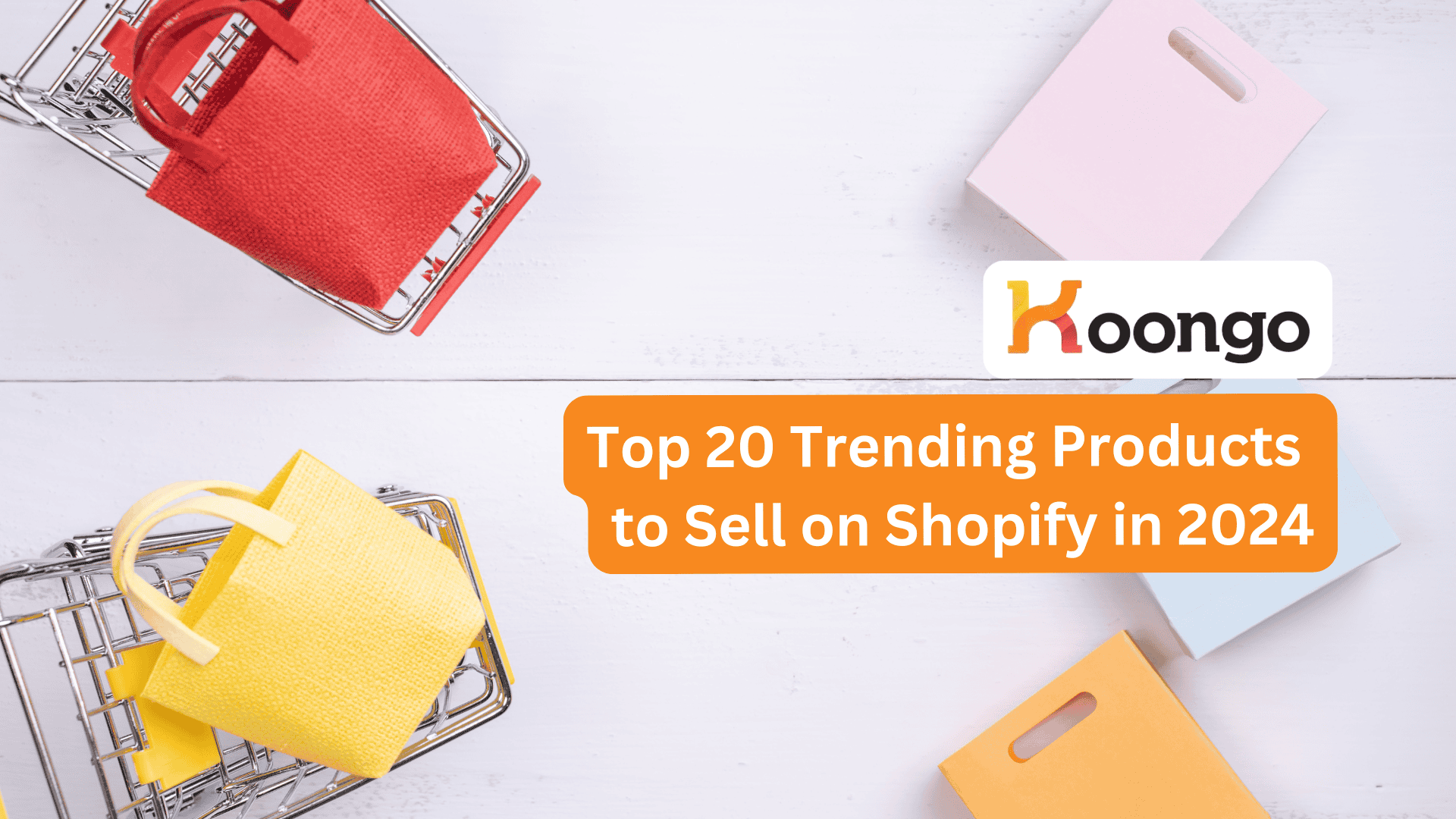Shopify makes it easy to create your own online store. Discover the top of trending products to sell on Shopify in 2024 and grow your business.
What is Shopify?

Shopify is a flexible ecommerce platform enabling users to create a professional online store without needing coding skills. Its user-friendly nature makes it ideal for both newcomers and experienced entrepreneurs. Shopify allows you to build a store that mirrors your brand, ensuring a seamless shopping experience for customers. Whether starting fresh or expanding an existing business, Shopify offers the necessary tools and flexibility for long-term success.
Shopify’s customizable structure helps users create distinctive ecommerce platforms that stand out in a competitive market. From small businesses to large brands, anyone can utilize its intuitive interface to build their own ecommerce store. The platform also integrates seamlessly with various ecommerce marketplaces, simplifying product management and expanding reach to a broader audience.
Shopify Pricing Plans
Shopify offers three main pricing plans, beginning with the Basic plan at $39 per month. Each plan includes unique features designed to support both new and established online stores. This scalable pricing structure ensures that Shopify can grow with your business, providing more advanced tools as your needs evolve.
Additionally, Shopify provides a free trial period, allowing users to explore the platform’s capabilities before committing to a subscription. This approach, combined with payment processing fees that apply only to sales, makes Shopify a cost-effective solution for online retailers.
Who Should Use Shopify?
Shopify caters to a broad range of users, from beginners to established brands. Its user-friendly tools are perfect for newcomers, while its advanced features meet the needs of more experienced store owners. Whether you’re just starting out or looking to enhance an existing ecommerce business, Shopify equips you with the resources necessary to effectively reach and engage your target audience.
How to Get Started on Shopify

Starting on Shopify is simple and rewarding. The platform enables users to create, manage, and grow their online stores with ease, offering complete control over branding and customer experience. Prioritizing performance and user experience from the outset can boost credibility and attract more shoppers to your store.
For those looking to streamline their product management and marketing efforts, integrating Koongo into your Shopify setup can be a game-changer. Koongo automates product data synchronization across multiple sales channels, ensuring that your store’s information is always up-to-date and consistent. With Koongo, you can easily manage your Shopify store’s product listings, optimize your presence on various marketplaces, and ultimately drive more sales with less effort.
Signing Up and Initial Setup
Creating an account with Shopify is straightforward. Simply provide your email and business information to get started. Shopify offers a trial option without requiring a credit card, allowing new business owners to explore the platform without a financial commitment.
After signing up, familiarize yourself with the platform to ensure a smooth setup. Completing initial tasks such as adding products and customizing your store’s appearance will lay a strong foundation for your online business.
Choosing a Domain Name
Selecting the right domain name is crucial for establishing your online presence. Shopify’s free domain name generator can help you brainstorm and find an available domain that reflects your brand identity.
A well-chosen domain name enhances your brand’s image and builds customer trust, making it a vital step in setting up your store.
Setting Up Payments
Shopify makes setting up payments easy and secure. Shopify Payments allows you to accept payments directly through the platform, eliminating the need for additional gateways. Activating Shopify Payments requires your EIN, business type, address, SSN, customer billing statement, and banking information.
Adding options like PayPal can improve payment security and provide customers with more choices, accommodating various payment preferences and making purchases easier.
Configuring Shipping Settings
Shopify’s shipping settings help you reach a broader market. By navigating to ‘Settings’ and clicking on ‘Shipping and Delivery,’ you can set your shipping address, select rates, and choose carriers. Offering worldwide shipping can expand your customer base and increase sales.
Shopify supports multiple shipping strategies, including free shipping and real-time carrier rates, to meet diverse customer needs. Discover more about Shopify E-commerce platform here.
Designing Your Shopify Store

Designing your Shopify store allows your creativity to shine. Shopify’s diverse theme library includes both free and premium options, which can be customized to reflect your brand identity. A visually appealing store attracts and converts visitors into customers.
Focusing on performance, accessibility, and user experience will help you create a successful Shopify store that stands out in a competitive market.
Selecting and Customizing Themes
Choosing and customizing a theme is an essential step in designing your Shopify store. Shopify offers themes tailored to various industries, helping you find one that fits your business needs. Adopting a mobile-first approach ensures a seamless experience across all devices, catering to the growing number of mobile shoppers.
Customizing your theme to match your brand’s identity creates a consistent and professional look for your store, enhancing customer trust and engagement.
Creating Product Pages
Effective product pages are crucial for converting visitors into customers. Here are some key elements to consider:
- High-quality images
- Clear, engaging descriptions
- Zoomable images
- Descriptive alt text
These elements not only enhance the user experience but also improve SEO, making your products more discoverable. A user-friendly layout and customer reviews can further boost buyer confidence and drive sales.
Adding Apps for Enhanced Functionality
Integrating apps into your Shopify store can significantly enhance its functionality. Apps for inventory management, email marketing, and other tasks streamline processes, improving efficiency and customer service. Automating tasks such as order tracking saves time and enhances the overall customer experience.
For example, Koongo offers seamless integration with Shopify, providing powerful tools to automate and manage your product data across multiple sales channels. By using Koongo, you can ensure your product listings are always up-to-date and synchronized, reducing manual work and minimizing errors.
Marketing Strategies for Your Shopify Store

Effective marketing is essential for any successful ecommerce store. Leveraging multiple sales channels—websites, marketplaces, and physical locations—helps reach a wider audience and boost sales. Implementing targeted marketing strategies will drive traffic to your Shopify store and convert visitors into customers.
Using apps from the Shopify app store can further enhance your marketing efforts by simplifying campaign management and performance tracking.
Utilizing Social Media Platforms
Social media platforms like Instagram, Facebook, and Pinterest are invaluable tools for promoting your Shopify store. By including your store URL in social media bios, you can direct traffic to your shop. Collaborating with influencers can also help you target specific niches and drive sales.
The Shopify app store offers tools like Facebook ads manager and email marketing apps to boost your social media marketing efforts. Utilizing these platforms effectively can increase brand visibility and drive more traffic to your online business.
Email Marketing Campaigns
Building and engaging an email list is crucial for driving sales and maintaining customer relationships. Offering lead magnets like discounts or exclusive content can effectively grow your email list.
Personalized emails and segmentation can improve engagement rates and encourage repeat purchases. Regularly analyzing your email campaign performance will help refine your strategies for better results.
Search Engine Optimization
Optimizing your product descriptions and titles with relevant keywords will improve your store’s search visibility. Mobile optimization is also vital, as Google prioritizes mobile-friendly websites. Using alt tags for images and creating content that addresses user questions will enhance your SEO, making your Shopify store more discoverable and driving organic traffic.
Analyzing and Optimizing Performance
Regularly analyzing and optimizing your store’s performance is crucial for long-term success. Shopify Analytics provides over 60 customizable dashboards and reports, offering insights into sales and customer behavior. These tools help track sales across marketing channels and manage inventory effectively.
Understanding key metrics like conversion rates and traffic sources allows you to make informed decisions, enhancing your store’s overall effectiveness.
Using Shopify Analytics
Shopify Analytics offers comprehensive tools for monitoring store performance. With over 60 customizable dashboards and reports, you can track sales, understand customer behavior, and manage inventory effectively. These insights help identify traffic sources and optimize marketing strategies.
Customizing reports to analyze specific metrics helps you make data-driven decisions that will boost your store’s performance.
Conducting Market Research
Thorough market research is crucial for understanding consumer demand and market feasibility. Gathering data through surveys, focus groups, and social media tracking offers valuable insights into customer preferences and effective pricing and marketing strategies.
Tools for analyzing online consumer behavior help assess demand for personalized products and identify market opportunities. Understanding competitor strategies is also vital for effectively positioning your brand in the market.
Adjusting Strategies Based on Data
Using data insights to refine your marketing efforts can significantly enhance store performance. Metrics like customer lifetime value and acquisition costs guide decision-making, ensuring better profitability. Data analysis optimizes product offerings and marketing tactics, increasing customer engagement and sales.
Continuously refining your marketing strategy based on data insights will improve efficiency and drive better results.
Top Trending Products to Sell on Shopify in 2024

Identifying trending products is essential for capturing consumer interest and driving sales. In 2024, several product categories are expected to dominate the ecommerce landscape, offering great opportunities for Shopify store owners. Staying ahead of market trends and aligning your offerings with consumer preferences will ensure your online business thrives.
Here are some top trending products to sell on Shopify this year:
- Sustainable Products: With consumers increasingly prioritizing eco-friendly practices, sustainable products are in high demand. Items like reusable shopping bags, biodegradable phone cases, and eco-friendly home goods are gaining popularity.
- Personalized Items: Personalized products remain a favorite among consumers seeking unique and customized goods. From personalized jewelry to custom apparel, offering items that cater to individual preferences can significantly boost your store’s appeal.
- Tech Accessories: In today’s digital age, tech accessories are essential. Products such as smartphone cases, wireless chargers, and smart home devices are in high demand. By offering high-quality tech accessories, you can attract tech-savvy customers and increase sales.
Summary
In 2024, the potential for building a successful Shopify store is immense. By understanding what Shopify is and how to leverage its features, you can create a thriving online business. From setting up your store and designing an attractive layout to implementing effective marketing strategies and analyzing performance, each step is crucial for success. Staying updated with market trends and offering trending products such as sustainable items, personalized goods, and tech accessories can further enhance your store’s appeal.
For even greater efficiency and growth, consider integrating Koongo into your Shopify store. Koongo simplifies product and order sync across multiple sales channels, saving you time and helping you scale your business. With Koongo’s automated solutions, you can focus more on growing your brand and less on the operational details.
Frequently Asked Questions
What makes Shopify a leading ecommerce platform?
Shopify stands out as a leading ecommerce platform because it’s incredibly user-friendly and customizable, making it perfect for anyone from newbies to seasoned brands. With its extensive features, you can easily create a professional online store without needing any coding skills.
How much does it cost to start a Shopify store?
Starting a Shopify store typically costs around $39/month, but you can try it out with a free trial first. That way, you can see if it fits your needs before spending any money.
What types of products should I consider selling on Shopify in 2024?
In 2024, consider selling sustainable items, personalized goods, and tech accessories on Shopify. These trending product categories are set to attract buyers and provide solid profit margins.
How can I optimize my Shopify store for better search visibility?
To boost your Shopify store’s search visibility, focus on optimizing product descriptions and titles with relevant keywords, ensure your site is mobile-friendly, and use alt tags for all your images. These steps can make a real difference!
What are the benefits of using Shopify Payments?
Using Shopify Payments simplifies your payment process by allowing direct transactions without additional gateways, which boosts security and eases management. It’s a win-win for streamlining your online store!

 EN
EN 
